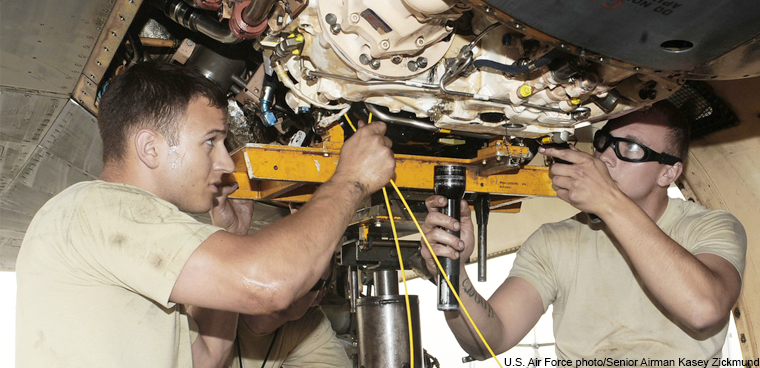App moves aircraft maintenance log to the flight line — Defense Systems

Connected Warrior
App moves aircraft maintenance log to the flight line
A mobile app that lets staff who maintain of Air Force combat aircraft perform and log maintenance directly on the flight line could save the service $153 million and about 2,700 full-time equivalent hours a year.
The Battle Record Information Core Environment app is the first mobile app in the Air Force that let maintainers do their job directly on the flight line. Historically, personnel have had to stop at various intervals to walk to a networked computer to log their progress -- a process that could take up to two hours, said Chris Gorman, chief operating officer and cofounder of Monkton, the software company that built the BRICE app.
“Maintainers didn’t have a convenient way to input their maintenance actions into the system of record.” Maj. Jonathan Jordan, Headquarters Air Force Reserve A6 logistics IT policy and strategy branch chief, said in a statement. “They have to travel to a desktop computer, go through the sign-in procedure for both the computer and the maintenance data system, then they can enter the data for the maintenance performed on the flight line.”
During user acceptance testing at Davis Monthan Air Force Base, Ariz., 81% of testers estimated the app saved them at least an hour per day. Additionally, because data entry happens in real time -- as opposed to maintainers writing notes on paper and transcribing them into the database after their shifts -- accuracy will likely improve.
BRICE is built with Monkton’s Rebar product, which has built-in compliance with the National Information Assurance Partnership (NIAP), a program managed by the National Security Agency that is responsible for implementation of the Common Criteria standards for computer security. Therefore, the app meets Defense Department security and authentication requirements to allow maintainers to input, store and send data in real time to the maintenance database.
Monkton worked with the service to integrate the app with its existing technology. Because maintainers were already using about 17,000 Apple iPads in a disconnected state because of security requirements, the company started by working to see if an iPad app could be built to connect securely with the Air Force’s system of record – a legacy COBOL-based mainframe at a Defense Information Systems Agency data center.
Monkton built a gateway to the Air Force’s Cloud Computing Environment, which uses Amazon Web Services' GovCloud, that let data go from the cloud to a DISA interface exchange called a cloud access point and then to the mainframe, giving the maintainers full connectivity in the field. BRICE uses Verizon LTE to connect to AWS GovCloud and then transverse that last mile.
“The end user doesn’t need to know that they’re hitting that old COBOL,” Gorman said. “What they see is this brand-new iOS interface in a way that a 19-year-old maintainer would expect to use Uber Eats or anything else.…. Now they’re performing their mission work in that same manner and interacting with the data there on the flight line, rather than having to make those multiple walks back to the toolshed to the networked PC.”
It took three months to go from kickoff to user acceptance testing. Based on the experience, Monkton has initiated Mission Mobility, a factory approach to quickly building and delivering mission-related mobile apps. Companies commit to building products that comply with Federal Information Processing Standards, the Federal Risk and Authorization Management Program and NIAP, and government agencies can select them knowing that they’re in compliance. Almost 15 companies, including Amazon, Apple and Samsung, are now onboard.
“Monkton already met DOD requirements before the first line of code was written,” Gorman said. “If we are all, from an industry standpoint, supporting the right policies, then we are protecting either the private sector or the public sector.”
App developers use the software development kit (SDK) that Monkton provides through Rebar, which lets them call the NIAP-compliant library.
“Essentially, what we provide is all the data at rest, all the data in transit and then the authentication and authorization,” Gorman said.
“You could really take the same Candy Crush development team, have them work with their normal development processes, but instead of calling the traditional security library that they would using with Swift or [Apple] XCode, they would use the Rebar SDK," he said. "When they went to compile that final build of the app, you would have an app that you could push through for classified daily use at a secret or top-secret level that would be independently evaluated.”
At the Air Force, the need for change became apparent after the Government Accountability Office found in 2018 that the Air Force was short the number of maintainers it needed to meet former DOD Secretary Jim Mattis’ call for all fighter jets’ readiness to be at 80%. “As of August 2018, the Air Force had requested an increased end strength of 8,000 personnel to fill critical personnel needs in maintenance and pilots,” GAO’s report stated.
“When you don’t have enough people and then you’re burning hours, which you already don’t have, that led to some of the backlog,” Gorman said.
The Air Force has deployed the app to about 200 users so far. The original rollout was specific to the A-10 Warthog plane, but the company has modified the app to support the rest of the combat Air Force.








Gloss